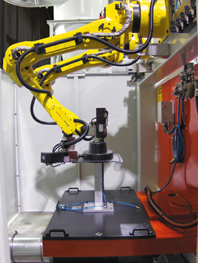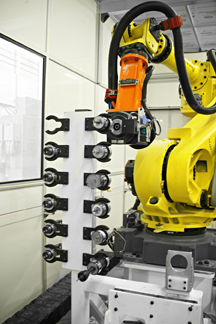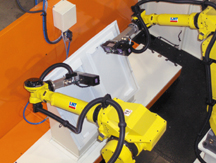|
The Benefits of Robotic Trimming

Flexibility, productivity,
safety,
quality and cost-competitiveness:
these are the attributes
that can make
or break the business
of a heavy gage thermoformer.
The ability
to have trimming
processes that deliver
all of these attributes
can greatly enhance
the thermoformer’s
success. The goal of this article is to familiarize thermoformers
with the attributes and benefits that can be
achieved using robotic trimming systems over the other
trimming choices available.
Implementing robotic trimming automation requires a
deep understanding of “path intensive” motion requirements
and
the other
supporting
technologies
required to
maximize
the benefits
that can be
achieved
with a robotic
trimming
system. Take
care to
select a
System
Integrator
that fully
understands
the requirements
of
trimming
applications
to take full
advantage of
the potential benefits. This article is based upon KMT
Robotic Solutions’ (KMT-RS) many years of success
working with thermoforming companies to implement
robotic trimming solutions.
Flexibility

The ability to easily program for a variety of parts,
to be able to add in new parts over time and to efficiently
implement part changeovers is key to the thermoformer’s
production flexibility. Making this efficient
requires a combination of off-line programming tools,
system calibration features and program management
tools that specifically address these flexibility
requirements. With these features in place, changeovers between parts can typically be implemented in
about a quarter of
the time it takes to
changeover a CNC
machine.
Flexibility also
comes from the ability
to reprogram for
part design changes.
KMT-RS provided a
production system to
one thermoformer
that used this equipment
to implement a
series of short prototype
part runs for their customer. This allows their customer
to work through an intensive product design change
period in a fraction of the time that it took them when the
parts were trimmed using trim dies. Now their customer is
demanding that all future part programs be implemented
with robotic trimming for prototyping and production so
that they get the benefits of the part change flexibility
available during the prototyping stage.
The ability to use a variety of tools on the same
robot is another type of flexibility that can be provided.
This can be more traditional with a variety of cutting
tools being available to an automatic tool change
routing spindle, or more advanced. An example of
more advanced tool change would be a robot dropping
off the routing spindle and picking up a compliant
knife to facilitate fine edge finishing.
Flexibility is also delivered through having a wider
range of motion with a 6-axis robot arm, providing
the ability to process a wide range of part sizes,
including taller parts. CNC machine pricing is heavily
influenced by
the Z stroke
required while
robots can
often process
tall parts at no
added cost.
Flexibility is
also available
with the option
of adding
capacity as
production
requirements
increase. For
example,
adding another
trimming position
or another
robot arm to a
system can be
accomplished
to increase
throughput.
And the ultimate flexibility also
exists: if the need for the
robot in its current
process goes away, then
the robot can be retooled
and redeployed doing a
totally different process,
protecting your investment.
Productivity
Ease of changeover
part to part was mentioned
in the Flexibility
section. The time savings
over CNC changeovers
using a robotic system
equipped for fast
changeover results in less labor per changeover, less part
waste during set-up and more parts produced in a shift.
Another key attribute of productivity is the cycle time
achievable per part. The process used to cut the part primarily
governs the cutting speed, so CNC machines and
robotic trimming typically will not vary significantly in cut
time but the robot can implement faster tool changes and
Tool Center Point (TCP) calibrations than on a CNC and
make quicker motions between cuts, giving it a total cycle
time advantage. For example, spindle alignment can be
achieved automatically on the robot system within 90 seconds
while this process takes up to four times longer on a
CNC machine. Shorter per part cycle time plus faster worn
tool changes means more productivity per shift.
The ability of the robot to reach all around the part,
including from underneath the part, can impact the number
of set-ups required to trim a part. KMT-RS has customers
that have eliminated the second set-up required on
a CNC machine to process the underside of the part and
save the cost of the second part fixture along with increasing
their productivity.
 Reliable operation is also a key to high productivity.
Today’s industrial robots have Mean Time Between Failure
(MTBF) over 90K hours and never take a vacation day. The
maintenance requirements for the FANUC robot arms are
minimal consisting of annual lubrication and replacement
of 4 D Cell batteries. In addition, the robot is able to protect
itself and its tooling with Torque Overload Sensing
(TOS), so it stops upon collision. This approach is superior
to the mechanical break-away methods used on CNC
machines and facilitates much quicker recovery from unexpected
events, again improving productivity.
Reliable operation is also a key to high productivity.
Today’s industrial robots have Mean Time Between Failure
(MTBF) over 90K hours and never take a vacation day. The
maintenance requirements for the FANUC robot arms are
minimal consisting of annual lubrication and replacement
of 4 D Cell batteries. In addition, the robot is able to protect
itself and its tooling with Torque Overload Sensing
(TOS), so it stops upon collision. This approach is superior
to the mechanical break-away methods used on CNC
machines and facilitates much quicker recovery from unexpected
events, again improving productivity.
Safety
Operating a thermoforming business safely is essential
to controlling risk and its associated cost. Keeping team
members separated from high speed rotating equipment
is a benefit of a robotic trimming solution implemented
correctly with appropriate solid guards. In addition,
removing team members from repetitive, manual trimming
operations eliminates a major source of repetitive
motion injuries and the
associated insurance
liability.
Quality
Robots deliver repeatable
processes with consistent
results. They don’t
get bored or distracted
and they can be programmed
to insure that
the right features get
trimmed into every part.
This is very important
when there are lots of
option choices that
impact the features to be
trimmed in a part.
KMT-RS has had experience with a range of plastic and
thermoformed parts that require tight tolerance trimming
that is challenging due to the part distortion or variable
shrink rates. To overcome this challenge, KMT-RS has
developed patent-pending AccuFind® sensing technology
that can be implemented to locate the part and specific
key features and make 3D offsets to the robot’s trim path
to the new position of the part and features. This unique
approach minimizes additional cycle time required, protecting
productivity while delivering part quality.
Cost Competitiveness
Reliable and repeatable processes lead to better control
of the manufacturing critical path, predictability and
reductions in manufacturing time, and more consistent
high product quality. This provides the opportunity for
the thermoformer to take a more aggressive pricing position
at less risk when going after new business. KMT-RS
has many customers that have revised their approach to
quoting projects based on their new economics with
robotic trimming and have won back business that was
previously lost.
Flexible Robotic Trimming, implemented effectively, can
offer your company the opportunity to improve process
throughput, have more reliable and repeatable processes,
improve product quality and consistency, remove your
employees from potentially hazardous jobs and increase
cost competitiveness. This can lead to a variety of benefits
for the business, including improved relationships with
customers, opportunities to win new business and
improved financial results. Consider how your business
can be impacted with the power of Flexibility, Productivity,
Safety, Quality and Cost Competitiveness, and create a
plan to add robotic trimming to your business model.
Written by Roberta Zald and Paul Schuch, KMT Robotic
Solutions, Inc.
For more information, contact Roberta
Zald, KMT Robotic Solutions, Inc., 1255 Harmon Road,
Auburn Hills, MI 48326, 248-829-28014, Fax: 248-829-2750, E-mail: roberta.zald@kmtgroup.com, Web: www.kmtrobotic.com.
|